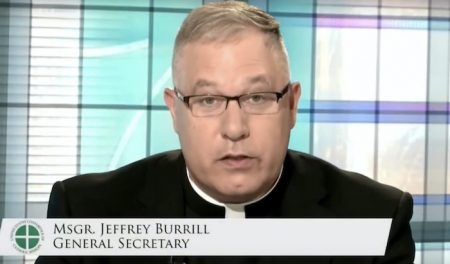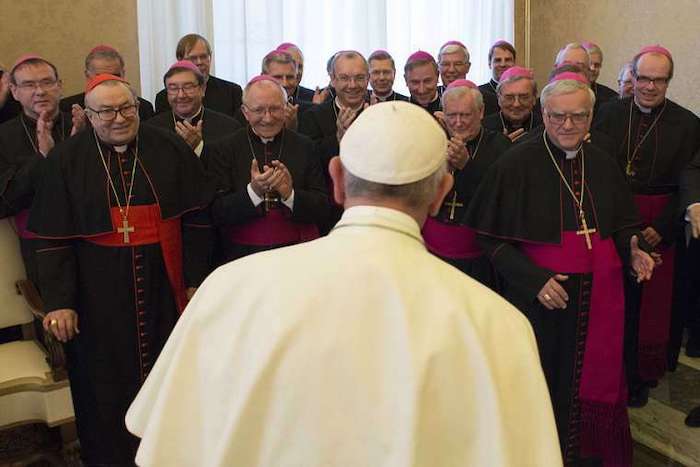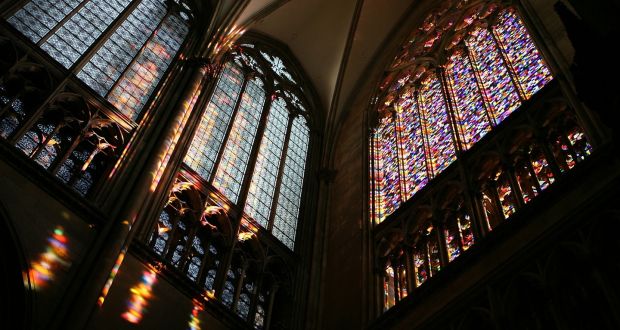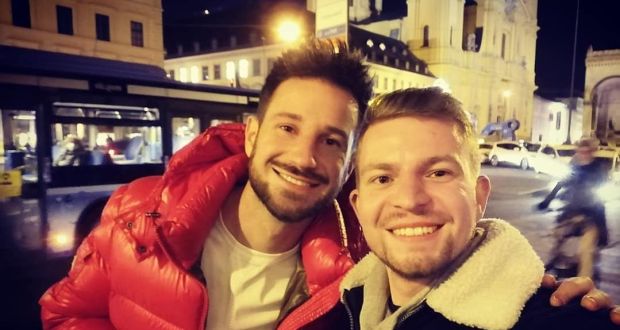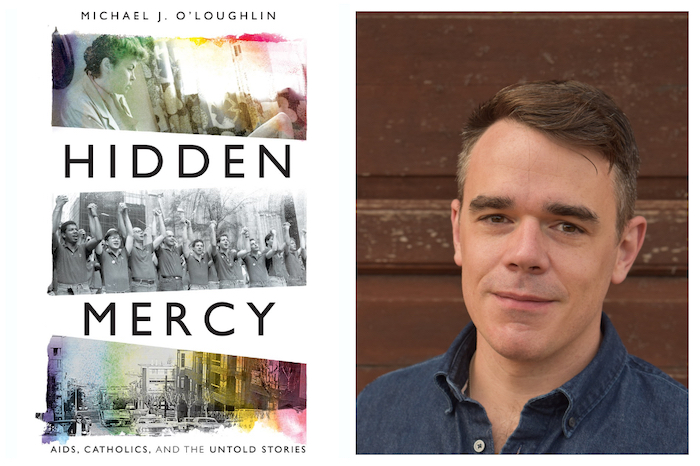
By Andru Zodrow
On Nov. 12, The Spectator had the privilege of conducting a phone interview with Michael O’Loughlin, a national correspondent at America Magazine. As a gay Catholic journalist, he has spent the past several years exploring the intersection between these identities. His new book, “Hidden Mercy,” uncovers the response of the Catholic church to the AIDS crisis, including the inspiring acts of priests, nuns and laypeople who ministered to and assisted young gay men that were marginalized in the church and larger society during the turbulent 1980s and ’90s.
Just three days after that interview in which O’Loughlin shared his thoughts about LGBTQ+ issues in the church, he published a guest column in the New York Times sharing that the Holy Father himself had congratulated him on his new book. Pope Francis reflected upon the importance of accompanying the marginalized, and thanked O’Loughlin for his work.
“Thank you for shining a light on the lives and bearing witness to the many priests, religious sisters and lay people, who opted to accompany, support and help their brothers and sisters who were sick from HIV and AIDS at great risk to their profession and reputation,” Pope Francis wrote.
Given that the book merited the praise of the Vicar of Christ, “Hidden Mercy,” is a must-read for anyone interested in LGBTQ+ issues, the Catholic church or both. Here is a lightly edited transcript of The Spectator’s interview with O’Loughlin.
AZ: Could you explain your initial inspiration for writing this book?
MO: I’ve been reporting on the Catholic Church for about a decade now, and a lot of my reporting was focused on LGBTQ+ issues. Partly because the debate about same-sex marriage was heating up when I started reporting, but a big part was because I’m a gay Catholic myself, and I was just really curious what church leaders were doing in this area, and how other gay Catholics felt about whether they were welcomed in the church or were finding a place in the Church.
It felt new, and like I was the only person who had done this because I didn’t have any understanding of the history of the fight for gay rights in the Church, and I wanted to fix that.
I was trying to just look at this time in the 1980s and ’90s, because there was this big clash between the LGBTQ+ community and the Catholic Church, at a time when HIV and AIDS was really taking a toll on the gay community. I hadn’t known that history. So I started reaching out to people who lived or worked through that time to just ask them, ‘what was it like back then, what was it like to be a gay Catholic faced with the brutality of HIV and AIDS, but also dedicated to your Church, which is fighting against gay rights,’ or ‘what was it like to be a priest ministering to people with AIDS?’ I was learning a lot of this history and realized that there was this whole generations-worth of wisdom that had been cut off for me, so my goal was to capture some of the stories and then present them in a way that might benefit other people as well.
AZ: You managed to compile all of this reporting several decades after the crisis itself. Can you explain what kind of challenges reporting on a decades-old event posed for you as a writer?
MO: That’s a great question. One of the decisions I made early on in the project was, I wanted to include interviews and meet with people who are still alive. So, unfortunately with HIV and AIDS, that cut out almost an entire generation of gay men, because they just simply didn’t survive. We’ve lost all of that wisdom unless their story has been told in other ways. It’s a limited set of experiences, but important nonetheless. I did go into some history, I used a lot of newspaper archives, and there was some great documentary material, audio, news reports—things like that, but ultimately, I decided, the most fruitful endeavor would be to talk to people who are still living.
AZ: In the “Letter to the Bishops of the Catholic Church on the Pastoral Care of Homosexual Persons,” or the ‘Halloween Letter,’ which was indirectly aimed at groups like Dignity, Cardinal Ratzinger (the future Pope Benedict XVI) stated that homosexuality is “a more or less strong tendency ordered toward an intrinsic moral evil.” Do you think that this is still the way the Congregation for the Doctrine of the Faith thanks about homosexuality today?
MO: I can’t speak for what any Vatican official or the Congregation thinks, but I think there is a sort of implicit homophobia that permeates a lot of discussion in the church around this issue. Some people would prefer that we just don’t talk about it because it is still taboo, both here in the U.S., and especially around the world where the Church is growing.
I think there’s a fear that if we talk about this too much, who knows where it will lead, and I think that’s what’s been so refreshing about Pope Francis—he’s actually encouraged us to talk about this issue, dating back to the earliest days of his pontificate, but also, especially during the Synod of Bishops on the family in 2014-2015. The Pope is simply saying, ‘don’t be afraid of this,’ he hasn’t changed church teaching, but he says ‘let’s listen to people’s lived experiences and see what their stories have to teach us about our faith.’
AZ: There’s a point in the book in which Fr. Bill McNichols says “the church will come around when it discovers that there are gay people who have lived full Christian lives and faced death with courage.” What work do we as Catholics need to be doing now to realize this reality in the future?
MO: I think being intentional about collecting stories while people are still with us because we’re more than three decades out from the crisis now, and if you were in your ’30s or ’40s, you’re getting up in age now. I think part of my project has been preserving these stories. Let’s make sure that they are part of history, because I think there’s still a fairly un-nuanced understanding of this time, especially when it comes to the Catholic Church.
Collect these stories by forming intergenerational friendships: younger people being intentional about reaching out to older people and asking about their experiences. I can’t tell you the number of times I’ve heard from either listeners of the Plague Podcast or people who have read early copies of the book, who have said that they haven’t been asked about their experiences in decades. These were harrowing, difficult times for people and to just see society move on so quickly, I imagine, could be difficult. I think Catholics should be intentional about not being afraid of what they might uncover when looking at this time in history, because there was a lot of shame and stigma, but [we should] be unafraid to deal with that, because there are inspiring stories like the ones I’ve collected in the book.
AZ: Why was Cardinal O’Connor on the Presidential AIDS Commission?
MO: There was a sense that the Reagan Administration didn’t want to deal with this issue because their base found the topics of homosexuality, IV drug use and the sexual revolution to be morally taboo, and they didn’t want to talk about it.
Now, the public health angle was, ‘we have to talk about how slow the spread of HIV,’ whether that’s the use of condoms or drug treatment programs, and Reagan was trying to appease his base by appointing a religious figure to the AIDS Commission to say that ‘the moral dimension of this public health crisis will be taken seriously in the White House.’
O’Connor himself was skeptical of the idea, but he accepted the invitation after a couple meetings. But ultimately it didn’t satisfy critics who said that the White House failed to treat this as a public health crisis, and you can’t attach morality to those kinds of things, so it was a complicated thing. It does show the political power that someone like Cardinal O’Connor has. I think it’s difficult for younger Catholics today to understand the political influence of Catholic bishops in the ’60s, ’70s and ’80s, and O’Connor’s inclusion on that commission shows that he had a direct line to the president, and that’s important to understand when we look at the church’s role in shaping the public health debate in the ’80s and ’90s.
AZ: Do you think that the Church has grown better at listening since the AIDS crisis?
MO: I asked Father Bill McNichols if he thought it was easier to be a gay Catholic or a gay Catholic priest today because of how much society has advanced, and he told me he didn’t. He thought it was actually easier in the ’80s because there was almost more of a willingness to look at people’s experiences, whereas today there seems to be more fear around the issue, so I think I agree with him on that.
I think figures like Pope Francis certainly show that there are church leaders who want to engage in dialogue and listening, and that’s been a major theme of his papacy, but I think there might be a tendency to be afraid as society changes its views on homosexuality. I think we see a lot of that in the Church in this country.
AZ: A major study of American Catholic priests was released just last week, and some information I found dismaying was that American priests ordained after 2010 are far more likely to believe that homosexual behavior is “always sinful,” compared to priests ordained prior to 1981. It seems the clergy is growing less tolerant while society becomes more inclusive of LGBTQ+ people. Do you think this will impact the relationship of the church with LGBTQ+ Catholics in the coming years and, if so, how?
MO: I think data like that shows how important it is that LGBTQ+ Catholics who want to stay part of the church make that decision and then stay, and make sure that their voices are heard, because something I’ve learned is that any welcoming Catholic space—any place which embraces and welcomes LGBTQ+ people—it was never inevitable. We look at places like Most Holy Redeemer in San Francisco, or St. Vincent’s Hospital in New York, or affirming parishes anywhere in the U.S., it was never inevitable that would be the case. It took hard work from LGBTQ+ Catholics and their allies to form those places into spaces that were safe and welcoming. Regardless of the views of young priests, I think that will be necessary work over the coming decades. But I am encouraged that there are visible and articulate young LGBTQ+ Catholics who are saying that they aren’t leaving, that they are staying in the Church, and these are the kind of spaces they are demanding. I think it’ll be an ongoing conversation for decades, regardless of the views of younger clergy.
AZ: What does making your voice heard as a gay Catholic look like today?
MO: That’s a great question, and one I haven’t thought about much. I guess for me, it’s been this notion of forging ahead with these projects, even if sometimes there’s some pushback that we shouldn’t explore too much of this history, because there is some shame and stigma still attached. I think it means going to mass and being part of the community, not being afraid of the resistance you might encounter. I understand that for some LGBTQ+ people, being part of a Catholic community might not be a healthy decision, especially if there’s one that’s particularly intolerant, but if you are called to take your faith seriously and you’re able to find a community that works for you, I think showing up is the first important step. Being visible, joining parish activities, engaging Catholic media—all the things that other Catholics are doing, who are making their view known, I think younger LGBTQ+ people have the same calling.
AZ: Did writing this book change the way you approach your own faith at all?
MO: It did. When I started writing probably five years ago or so, I had an initial conversation with Sister Carol, and I was afraid to tell her that I was gay because I didn’t know how she would react, which in introspect, is completely absurd because she had been caring for gay men dying from AIDS for more than a decade, and she’d become an ally for the LGBTQ+ community. But there was still something internal within me that made me clam up and be unsure about how much of myself I should reveal to her. After meeting people like Sister Carol and other advocates now for the past five years, doing dozens and dozens of interviews, I really internalized this idea that I can be honest about myself and be totally committed to my faith at the same time and that’s been a journey. I don’t think it ever goes away. Father Bill told me that it doesn’t get easier to come out, it just means you have to keep doing it and doing it, and eventually you come out, but you still have that fear, so I do think it will be an ongoing process. But there is this sense that knowing the history that I write about in the book does give me—and I think it gives other people—the ability to see that they do have a place in the church and to make them understand their faith in a different way.
AZ: The theme of frustration or hurt with the institutional Church seems to have emerged over the course of the book. Did you notice any patterns of how priests and nuns and laypeople were dealing with that frustration, or is it an individual journey for everyone?
MO: What I took away was that it was an individual journey for everyone. What I tried to do in the book was profile people who approach that journey in a different way or in various ways, so there’s someone like David Pais, who I chronicle throughout the book, who was very active in the church, very active in Dignity, ultimately steps away from the Church, is away for several years, then he gets a degree in theology and he returns to the Church. It sort of has this stepping in and out, which I think is a fairly common thing for not just LGBTQ+ people but young people in general, and then as they advance in the years, they have a different relationship with the church, so that’s one example. I interviewed Sean Strub, who grew up in a very Catholic household and was very devoted to his faith, but when HIV hit, he saw the hypocrisy, was turned off by that and ultimately left the Church. Today, while he still understands why Catholicism is important to people, he is not a practicing Catholic himself. So, between David and Sean, there’s all kinds of people. People deal with this hurt they feel because they are LGBTQ+ from Catholic leaders in different ways.
Some people say they just ignore the statements that are hurtful and they find a parish that works for them. I hope I offered different models of how to deal with that because I don’t think it’s an issue that’s going to go away anytime soon.
AZ: Thank you so much for your time.
O’Loughlin is a sterling example of how LGBTQ+ journalists are documenting the interactions between the Church and queer Catholics. Pope Francis’ support of his work ought to serve as a source of hope and inspiration for gay Catholics, even as Church teachings regarding homosexuality remain static. As the global Church and LGBTQ+ Catholics learn how to interact more productively, journalists like O’Loughlin will continue to serve as an important source for information and analysis.
Complete Article ↪HERE↩!




